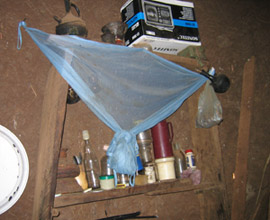Surveying more than 850 households in rural and urban areas of the country, the organization found that mosquito net use was significantly higher when nets were conical rather than rectangular, new rather than old, and white rather than blue.

One example of misuse of a mosquito net; in this home in Ethiopia, a mosquito net is used to protect dishes and cooking implements from insects. Source: Shoa Girma, AED
Why Some Mosquito Nets Are Not Used
Many countries across sub-Saharan Africa are currently increasing their coverage of insecticide-treated mosquito nets to combat malaria. Millions of nets are being procured and distributed to population groups at risk of the disease, often children and pregnant women. When visiting households in rural areas of Ethiopia, for example, one can often see brand new nets hung above sleeping places, and villagers comment on how they now feel protected from malaria.
However, every now and again, one can observe nets that are used as tablecloths, curtains, or fishing nets. Large surveys also have shown that not everyone who owns a net uses it every night. Clearly, such behaviors will reduce the expected impact of nets on malaria transmission.
What makes people use or not use nets? The Academy for Educational Development, a PMI implementing partner in Ethiopia, set out to investigate this question. Surveying more than 850 households in rural and urban areas of the country, the organization found that mosquito net use was significantly higher when nets were conical rather than rectangular, new rather than old, and white rather than blue. The survey also showed that net use was greater if the net had been purchased rather than received for free and if households had been sprayed with insecticide.
PMI is now working with its implementing partners to incorporate these findings in its program activities. For example, PMI will support the distribution of 559,000 conical mosquito nets in late 2009 in Ethiopia. Additionally, the Academy for Educational Development is carrying out comprehensive health education activities to ensure that all nets distributed will be used correctly.
